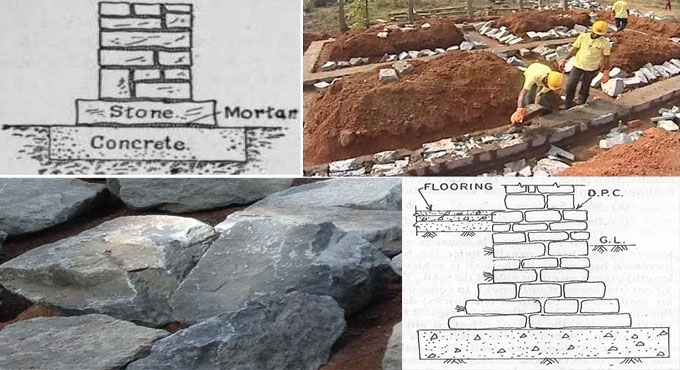
Method of stone masonry footing construction
Stone masonry is defined as a composite material built up with stone units and mortar (sometimes only stones), assembled in a different way and utilized for building up load-bearing structures. Stone masonry footing stands for a structural foundation that is built up to support walls. Given below, several characteristic of stone masonry footing.
Purpose of Stone Masonry Footing
The objective of stone masonry foundation is to provide support to structural walls and transmit the load to the soil located under it. It should fulfill its purpose devoid of any settlement or sinking. The load applied on stone masonry footing should have been vertical.
Construction of Stone Masonry Footing
Dimensions of Excavation for Stone Masonry Footing
Before starting the construction of stone masonry footing, a trench containing depth from 1m to 1.5 m should be excavated.
The width of excavation would be managed by amount of loads employed on the footing. So, the width of footing is indicated on the basis of the imposed loads and characteristics of soil on which the footing is built up.
Then, the soil at the bottom of the trench should have been compressed correctly. At this phase, the excavation is ready for the development of stone masonry footing.
Characteristics of Stones for Footing: To be eligible for the development of stone masonry footing, stones should contain the following characteristics:
a. The stone should be long lasting
b. It should not contain any cracks
c. It should not contain cavity
d. It should be rigid and sturdy
The different types of stones like granite, hard laminated stand stone and limestone, and bluestone can be used for stone masonry footing construction.
Preferred Dimensions of Stones
a. The density of stones should have been one fourth of their width
b. Ensure, the width of each stone employed for the construction of footing, first course should be identical with the stone masonry footing width. If such stones are unavailable, then joints should be arranged and it is suitable.
Formation of Stones for Stone Masonry Construction: Stones should have been sufficiently drenched prior to being placed in the foundation. This measure is intended to resist water absorption that adversely impacts the mortar.
Concrete Mix Ratio applied for Plain Concrete Bed: The plain concrete bed arranged at the bottom of the foundation is formed with one part of cement four part of sand and eight parts of coarse aggregate. The highest size of the aggregate is 40mm.
Dimensions of Plain Concrete Bed: The density of plain concrete bed varies from 10cm to 15cm. The plain concrete layer should expand about 15cm from the stone masonry foundation on every side of bottom course. So, the width of plain concrete is 30cm larger than the bottom course of stone masonry footing.


